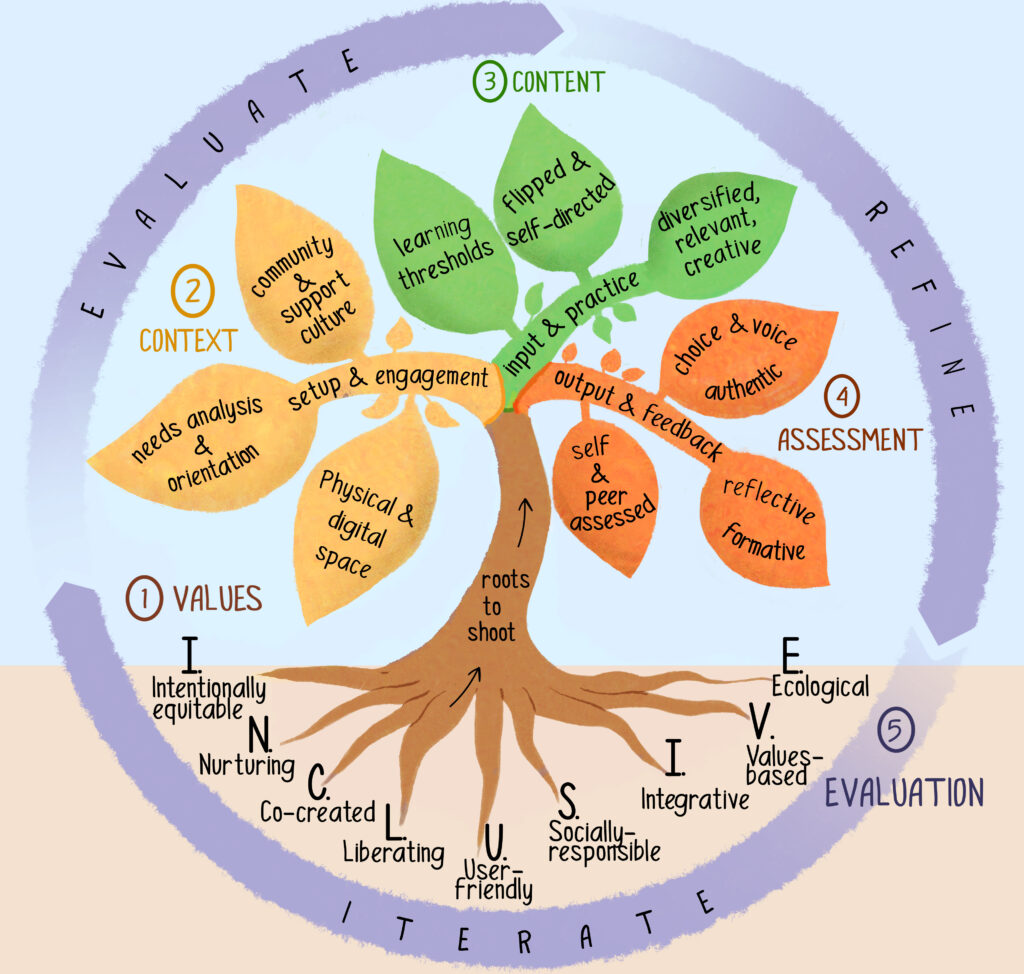(from the printed/ebook version)
Reading this book: roots to shoots
This book is less a recipe and more an invitation to reflect, to listen to a range of global perspectives and to consider what might work for you in your context. For many of us, the act of writing or sketching while engaging with a book can help clarify, make connections and draw implications from our experiences in new ways. So, you may want to keep a pencil at hand to make notes in the margins. This would also make it easier to revisit your thoughts at a later time.
I would also suggest you have some device with Internet connection nearby as there is a constant interplay between the book and the companion website inclusivelearningdesign.com including audio-visual materials.
In which order should you read this book? The roots-to-shoots approach provides a natural journey up the metaphorical inclusive learning design tree: first the roots (values); then the shoots connected to the three areas of context, content, and assessment; and finally the outer evaluation circle. So, you may want to read it in the order in which it is presented, especially if you are new to inclusive practices. However, the various sections can also stand by themselves if you are particularly interested in reading the later sections before the earlier ones, particularly if you consider yourself an inclusivity champion and are most interested in the case studies.
Please take a moment to examine the visual representation of the inclusive learning design tree below.
I am aware that there is a lot to take in when you first see this image. There are many elements to it because learning design is complex and cannot easily be reduced to a few elements. However, by splitting the image into roots, three branches with their leaves (or fruits) and the outer circle, I hope to provide a logical way to tackle the irreducible complexity of learning design.

Image: The inclusive learning design tree
This book invites you to travel through five phases of learning design:
1 Values
2 Context
3 Content
4 Assessment
5 Evaluation
These correspond to the sections in this book:
Section 1: Values—the roots
Here I introduce the roots-to-shoots tree metaphor to represent my approach to inclusive learning design. The focus of the section is on values which support inclusive learning design represented by the roots of the tree. I use the word ‘inclusive’ as an acronym for nine further inclusivity values that should drive the learning design process at every stage:
I. Intentionally equitable
N. Nurturing
C. Co-created
L. Liberated
U. User-friendly
S. Socially responsible
I. Integrative
V. Values-based
E. Ecological
For each root I propose a ‘stimulus’ in the form of a contributed short text from a variety of colleagues from various continents.
Co-creation is such an important inclusivity value that I dedicate a whole chapter to it at the end of the section. You will read the case-studies from the teacher and the students’ perspective of co-creating their learning and research.
Section 2: Learning context—set up and engagement
This is the (yellow) left branch of the tree. Here I discuss the importance of allowing the context to inform our learning design, including setting up support systems. The context will greatly affect if and how the students will engage with the course at all, so it is vital to carry out a thorough contextual analysis. This is in the sense of our institutional context, of the cultural and disciplinary context of the course, and of all the elements that form and inform the students context.
Section 3: Learning content—input and practice
This is the (green) central branch of the tree. I discuss the course content, often referred to as the syllabus, and which usually consists of the input and practice of key concepts and practices in the discipline. Making the content more inclusive is possible by considering how we present it and how we ask the students to engage with it. Accessibility and universal design take centre stage here.
Section 4: Learning assessment—output and feedback
This is the (orange) right branch of the tree. Here I discuss the critical area of inclusive assessment by focussing on the design of varied, reflective outputs. Outputs from the students are what they design, write, make, do, say as a result of their learning. These outputs often coincide with formative or summative assessment points, for the students themselves, their peers and us, the teachers, to gauge learning progress.
Section 5: Learning evaluation—the outer circle
The circle with the arrows signals an all-important aspect of good teaching and learning: its evaluation is an ongoing effort. The words on the arrows—evaluate, iterate, refine— are the key concepts and practices discussed in this section.
Before starting the roots-to-shoots journey, I invite you to read the ‘Key concepts and background’ to the writing of this book.
Citation
Rossi, V. (2023) Inclusive Learning Design in Higher Education – A Practical Guide to Creating Equitable Learning Experiences. London: Routledge
